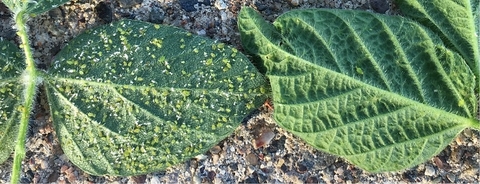- Soybean aphid is an invasive pest of soybean that continues to cause economic damage in Minnesota.
- To prevent economic loss, producers commonly apply foliar insecticides when aphid densities reach 250 aphids per plant.
- Yield loss and control costs can be significant for Upper Midwest soybean growers.
Aphid-resistant genes (Rag genes)
Using aphid-resistant soybean varieties holds promise as a more sustainable approach to soybean aphid management.
Soybean varieties that possess resistance genes, called Rag genes (Rag1, Rag2, etc.), affect the colonization and population growth of soybean aphid.
Soybean varieties with Rag1 or Rag2 genes have significantly suppressed aphid numbers and protected yields in multiple states over multiple years. Varieties with multiple (i.e., pyramided) Rag genes can provide further protection.
Independent university research has shown that varieties can have Rag1 and Rag2 genes without reducing yield, compared to similar aphid-susceptible soybean lines not under aphid pressure.
Resistant varieties offer season-long protection from aphids. In contrast, insecticidal seed treatments (neonicotinoids) only provide temporary protection up to about 40 days after planting. This is typically before aphid populations establish.
Using resistant varieties also reduces the likelihood of needing to apply foliar insecticides for soybean aphid.
Availability of aphid-resistant soybean
Commercial varieties containing Rag genes have been available since 2009 but were uncommon among early-maturity soybean varieties developed for Minnesota.
A search of seed catalogs identified several soybean varieties with aphid-resistance (Rag) genes in early-maturity groups and with other traits potentially suitable for Minnesota soybean growers.
Soybean varieties carrying the Rag genes available in Minnesota as of January 2019
| Brand names | Company | Relative maturity | Resistance gene(s) | Herbicide resistance trait | Other advertised characteristics |
|---|---|---|---|---|---|
| 64G94 | Rea Hybrids | 0.4 | Not listed | Genuity RR 2 Yield | IDC tolerant; SCN resistance |
| Viking 0.0654AT | Viking Seeds | 0.6 | Rag1 | None | PRR susceptible; organic seed |
| Viking 0.1544AT | Viking Seeds | 1.5 | Rag1 | None | IDC tolerant; SCN susceptible; organic seed |
| Viking 0.1955AT | Viking Seeds | 1.9 | Rag1 | None | PRR tolerant; BSR susceptible; organic seed |
| Viking 2188AT12N | Viking Seeds | 2.1 | Rag1 & Rag2 | None | SCN resistance |
| Viking 0.IA2113RA12 | Viking Seeds | 2.2 | Rag1 & Rag2 | None | SCN resistance; organic seed |
| Viking 0.2188AT12NUP | Viking Seeds | 2.5 | Rag1 & Rag2 | None | SCN resistance; organic seed |
*PRR: Phytopthora root rot; SCN: Soybean cyst nematode; IDC: Iron deficiency chlorosis; SDS: Sudden death syndrome; BSR: Brown stem rot
Continue to scout for aphids
It’s important to continue scouting for soybean aphids because they can occasionally reach damage levels on resistant plants.
Soybean aphid populations (biotypes) that can overcome aphid-resistance genes exist, but their occurrence varies from region to region and year to year.
Recent research shows that resistant varieties are compatible with current scouting recommendations for estimating aphid densities and compatible with insecticide use in cases where scouting recommends treatment.
While soybean varieties with single resistance genes, such as Rag1 alone, have effectively suppressed soybean aphid in Minnesota, varieties with pyramided resistance genes, such as Rag1+Rag2, offer more robust protection from resistance-breaking aphid biotypes.
Planting well-adapted aphid-resistant varieties could improve the sustainability of soybean production.
Brace, R.C. & Fehr, W.H. (2012). Impact of combining the Rag1 and Rag2 alleles for aphid resistance on agronomic and seed traits of soybean. Crop Science, 52, 2070-2074. https://doi.org/10.2135/cropsci2011.12.0637
Cooper et al. (2015). Geographic distribution of soybean aphid biotypes in the United States and Canada during 2008-2010. Crop Science, 55, 2598-2608.
da Silva Queiroz, O et al. 2018. Impact of single gene and pyramided aphid-resistant soybean on movement and spatial pattern of soybean aphid (Hemiptera: Aphididae), J. Econ. Entomol. 111: 2946–2955.
Hanson et al. (2016). Sources of soybean aphid resistance in early-maturing soybean germplasm. Crop Science, 56, 154-163. https://doi.org/10.2135/cropsci2015.05.0287
Hanson et al. 2018. Interactions of host-plant resistance and foliar insecticides for soybean aphid management. Crop Prot. 112: 232-238
McCarville, M.T. & O’Neal, M.E. (2013). Soybean aphid (Aphididae: Hemiptera) population growth as affected by host plant resistance and an insecticidal seed treatment. Journal of Economic Entomology, 106, 1302-1309.
McCarville, M.T. et al. (2014). One gene versus two: A regional study on the efficacy of single gene versus pyramided resistance for soybean aphid management. Journal of Economic Entomology, 107, 1680-1687. https://lib.dr.iastate.edu/cgi/viewcontent.cgi?referer=&httpsredir=1&article=1258&context=ent_pubs
Reviewed in 2023


